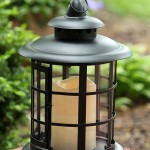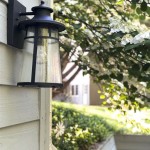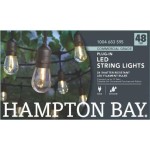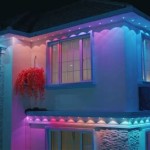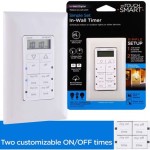Outdoor Ceiling Fans with Lights: Enhancing Comfort and Ambiance
Outdoor ceiling fans with lights are increasingly popular additions to patios, decks, porches, and other covered outdoor spaces. They offer a combination of functionality and aesthetics, providing both air circulation and illumination, making outdoor areas more comfortable and usable, especially during warmer months and at night. Understanding the features, benefits, and considerations associated with these fixtures is crucial for making informed purchasing decisions and ensuring optimal performance.
The primary function of an outdoor ceiling fan is to circulate air. In warm weather, the downward airflow created by the fan can create a cooling effect through convection and evaporation on the skin. In cooler weather, some fans can be reversed to create an upward airflow, which can help to redistribute warm air that rises, potentially improving energy efficiency in covered outdoor spaces that connect to the interior of a home. The integrated light fixture provides ambient lighting, allowing for extended use of the outdoor space after sunset. This combination of features makes outdoor ceiling fans with lights a versatile and practical investment for homeowners.
Selecting the Right Size and Type
Choosing the appropriate size and type of outdoor ceiling fan is paramount for achieving optimal performance. The size of the fan, measured by its blade span, should be proportional to the size of the outdoor area. A fan that is too small will not effectively circulate air, while a fan that is too large can create an uncomfortable or even turbulent airflow. Generally, larger outdoor spaces require larger fans with greater blade spans.
For example, a small patio of approximately 100 square feet may only require a fan with a 42-inch blade span. A larger deck of 200-400 square feet, however, may necessitate a fan with a 52-inch or even a 60-inch blade span. It's generally recommended to consult with a lighting or home improvement professional to determine the optimal fan size based on the specific dimensions and layout of the outdoor space.
Categorizing outdoor ceiling fans involves differentiating between damp-rated and wet-rated models. These ratings pertain to the fan's ability to withstand moisture and atmospheric conditions. Damp-rated fans are designed for covered outdoor areas, such as porches or patios with a roof, where they are protected from direct exposure to rain or snow. They are constructed with materials that resist moisture damage but are not intended to be directly exposed to the elements.
Wet-rated fans, on the other hand, are designed to withstand direct exposure to rain, snow, and other weather conditions. These fans are constructed with more robust materials and undergo stringent testing to ensure their durability and safety in exposed outdoor environments. For uncovered patios or areas prone to heavy moisture, a wet-rated fan is essential to ensure longevity and prevent electrical hazards. Choosing the appropriate rating is critical for safety and preventing premature failure of the fan.
In addition to damp and wet ratings, it is essential to consider the fan's motor type. There are generally two types of motors used in ceiling fans: AC (Alternating Current) and DC (Direct Current). AC motors are more traditional and typically less expensive, but they are generally less energy-efficient and offer fewer speed options.
DC motors, on the other hand, are more energy-efficient and offer a wider range of speed settings. They also tend to be quieter and more responsive to remote control commands. While DC motor fans may have a higher initial cost, the long-term energy savings and enhanced performance can outweigh the initial investment, particularly for fans that are used frequently.
Lighting Features and Options
The lighting component of an outdoor ceiling fan with lights provides both functional illumination and aesthetic enhancement to the outdoor space. There are various lighting options available, each with its own advantages and disadvantages. Traditional incandescent bulbs are relatively inexpensive but are less energy-efficient and have a shorter lifespan compared to more modern alternatives.
Halogen bulbs offer slightly improved energy efficiency and a brighter light output compared to incandescent bulbs, but they still consume more energy than LED options. Compact fluorescent lamps (CFLs) are more energy-efficient than incandescent and halogen bulbs but contain mercury, which requires careful disposal. They also may take a few moments to reach their full brightness.
Light-emitting diodes (LEDs) are the most energy-efficient and long-lasting lighting option available. They consume significantly less energy than other types of bulbs and have a lifespan that can extend to tens of thousands of hours. LED lights are also available in a wide range of color temperatures, allowing homeowners to customize the ambiance of their outdoor space. They also do not contain mercury, making them a more environmentally friendly choice.
Selecting the appropriate color temperature for the lighting is important for creating the desired atmosphere. Warm white light (around 2700-3000 Kelvin) creates a cozy and inviting ambiance, while cool white light (around 4000-5000 Kelvin) provides brighter, more focused illumination. Daylight light (around 6000-6500 Kelvin) mimics natural daylight and is suitable for tasks requiring high visibility. The choice of color temperature depends on the intended use of the outdoor space and the desired aesthetic.
The lighting fixture on an outdoor ceiling fan may also offer dimming capabilities. Dimming allows homeowners to adjust the brightness of the light to suit different activities and moods. Dimming can also help to conserve energy by reducing the light output when full brightness is not needed. It's important to ensure that the fan and the light bulbs are compatible with dimming functionality.
The style of the lighting fixture should complement the overall design of the outdoor space. There are a variety of styles available, ranging from traditional to modern, and in materials suited for the outdoors. Some fans feature integrated light kits, while others allow for the attachment of separate light fixtures. Consider the finish and materials of the fan and light fixture to ensure they coordinate with the existing outdoor furniture and décor.
Installation and Maintenance Considerations
Proper installation is crucial for ensuring the safe and reliable operation of an outdoor ceiling fan with lights. It is essential to follow the manufacturer's instructions carefully and to consult with a qualified electrician if necessary. The electrical wiring must be properly grounded and connected to a dedicated circuit breaker to prevent electrical hazards. A licensed electrician can ensure that the electrical connections are safe and comply with local building codes.
The fan should be securely mounted to a structurally sound ceiling joist or support beam. If the existing electrical box is not designed to support the weight of the fan, it may need to be replaced with a fan-rated electrical box. Using the appropriate mounting hardware is critical for preventing the fan from wobbling or falling. Fans also often include a downrod. Selecting the proper length of downrod is important to ensure the fan is at the appropriate height. Too high, and it won't properly circulate air. Too low, and there is a risk of hitting it.
Regular maintenance is essential for extending the lifespan of an outdoor ceiling fan and ensuring its optimal performance. Periodically inspect the fan blades for dust and debris, and clean them with a damp cloth. Dust and debris can accumulate on the blades, reducing their aerodynamic efficiency and causing the fan to wobble. Inspect the fan's motor and electrical connections for any signs of damage or wear. Tighten any loose screws or connections to prevent vibrations or electrical hazards.
Depending on the environment, saltwater air or extreme humidity may require more frequent maintenance. Some fans feature special coatings and materials designed to resist corrosion and degradation in harsh environments. These fans may require less frequent cleaning and maintenance but still benefit from regular inspection. Consider purchasing a fan with corrosion-resistant features if it will be installed in a coastal area or other harsh environment.
Replacing light bulbs in an outdoor ceiling fan can sometimes be challenging, depending on the design of the fixture. Before attempting to replace a light bulb, turn off the power to the fan at the circuit breaker to prevent electrical shock. Follow the manufacturer's instructions for accessing the light bulb and replacing it with the appropriate type and wattage. Consider using LED bulbs, as their extended lifespan will reduce the frequency of bulb replacements.
Consider obtaining professional maintenance on a regular basis. A professional can inspect the motor, blades, and connections and lubricate any moving parts. They can identify any potential problems early on and make necessary repairs to prevent more significant issues from developing. This can extend the life of the fan and ensure safe and efficient operation.

Big Outdoor Ceiling Fans For 2024 Hunter Fan

Outdoor Ceiling Fans إنارات

Dinglilighting Ceiling Fan With Light Flush Mount Fans Lights Low Profile Remote Control 42 Outdoor Timing Com

60 Wind And Sea Broe Finish Led Outdoor Ceiling Fan With Remote 24j52 Lamps Plus

52 Kichler Cameron Copper Led Outdoor Ceiling Fan With Remote 97y78 Lamps Plus

A Rich And Rustic Ceiling Fan Light Complements Any Outdoor Space With Wood Beam Http D

Everything You Need To Know About Outdoor Ceiling Fans Dan S Fan City Parts Accessories

Ceiling Fans With Lights And Remote 52 Inch Outdoor Fan Walnut Wood

Liberator 96 In Indoor Outdoor Oil Rubbed Broe Ceiling Fan Dan S City Fans Parts Accessories

Yardreeze 60 In Black Color Changing Led Indoor Outdoor Ceiling Fan With Light Remote 6 Blade The Fans Department At Com
Related Posts
